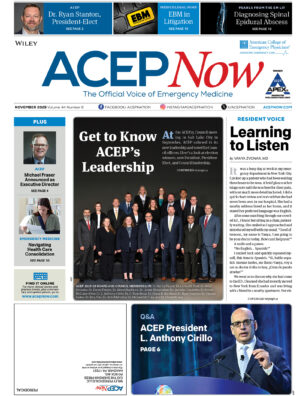
In the 1976 movie All the President’s Men about Watergate, the informant “Deep Throat” tells Bob Woodward (played by Robert Redford) to “just follow the money” to understand what happened and why. The saying is true in health care, too.
Explore This Issue
ACEP Now: Vol 36 – No 01 – January 2017In January 2014, Maryland dramatically shifted the financing of health care within the state by implementing global budget revenue (GBR) for all hospitals in Maryland. As previously discussed in the April 2014 issue of ACEP Now, this population-based payment model caps total hospital revenue growth. The rates and hospital revenues are set by the Health Services Cost Review Commission (HSCRC) for all acute-care hospitals in Maryland. The HSCRC has been in existence since 1974 as part of Maryland’s all-payer system that includes Medicare and Medicaid.
GBR was negotiated between the state of Maryland and the Centers for Medicare & Medicaid Services (CMS). The GBR essentially changes the payment system from a retroactive fee-for-service system to a prepaid global budget, which the hospitals must manage effectively.
While GBR does not currently directly impact health care providers and our fee-for-service model, it has the potential for expansion to providers in the future. If successful, this program has the potential for national dissemination by CMS and could dramatically impact how we practice emergency medicine.
GBR, which was implemented at the same time as the Affordable Care Act (ACA), has five main objectives related to population health and cost containment:
- Save Medicare $330 million over five years.
- Limit per capita yearly growth to less than 3.58 percent.
- Decrease 30-day hospital readmission rates.
- Decrease hospital-acquired conditions by 30 percent over five years.
- Keep growth of Medicare spending to less than 0.5 percent below the national average.
Initially, with Medicaid expansion and the ACA, there was a positive revenue impact for emergency providers in Maryland due to a decrease in self-pay patients and an increase in Medicaid coverage. This is consistent with what has been seen with the ACA in other states. With the advent of GBR, hospitals were now on the hook for providing care to a certain population, and there were efforts to improve resources such as increased case management and social services in the emergency department. These are positive changes, welcomed by the provider and patient community. Unlike other states, after Maryland implemented GBR, emergency department volumes have remained flat, and hospital admissions have not changed or have gone down for many hospitals.
However, with this essentially being a capitation model for hospitals, they have significant incentives to decrease expenditures. How will this occur? The less care delivered, the fewer expenses hospitals incur. The GBR model regulates revenue as well, leaving fewer options to change the bottom line by increasing services. So “just follow the money.”
If hospitals decrease inpatient admissions, they will spend less on care delivery. Hospital admissions have become more focused on expense than revenue. The focus on decreasing expenses has led to fewer available beds, increased boarding, crowded emergency departments, and more nursing shortages, including an increase in absenteeism. In addition, more effort is being made to find other sources of care for patients. With the increase in case management and social services, more patients are also able to go home with prearranged services such as home health.
In the emergency department at many hospitals, there seems to be a decreased institutional emphasis on metrics such as “left without being seen.” Low-acuity visits equate to higher costs than in other settings. At times, it feels like the care we used to provide in the main emergency department has been moved out to the waiting room since many of our beds are filled with admissions.
While the initial impact of the GBR model was positive, as the “easy money” disappears, more and more pressure occurs to find new and innovative means to decrease expenditures. Unlike the current fee-for-service model, in which hospitals and providers are mostly paid for care delivered (services provided), the GBR model is intended to incentivize the delivery of more care in less expensive settings. While intended to improve quality and decrease cost, the unintended consequence may be to delay care for our patients across the spectrum.
Dr. Hirshon is professor in the departments of emergency medicine and of epidemiology and public health at the University of Maryland School of Medicine in Baltimore. Dr. Jaquis is system chief of emergency medicine at LifeBridge Health and chief of emergency medicine and attending physician at Sinai Hospital, both in Baltimore.
Pages: 1 2 | Multi-Page




No Responses to “Maryland Hospitals Feel Impact of Global Budget Revenue Model”